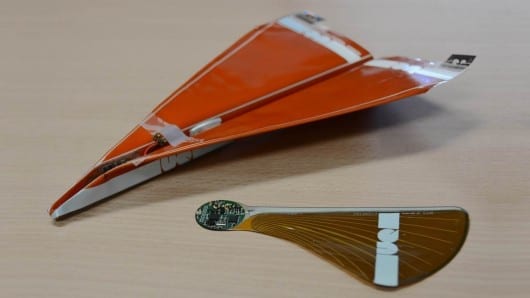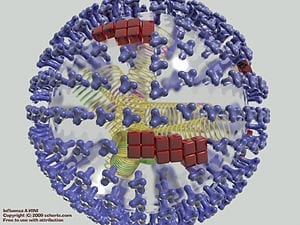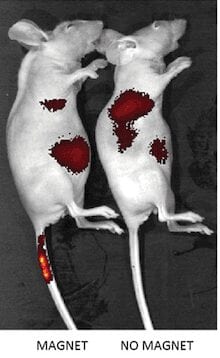
So cheap and easy to manufacture that they’ll literally be disposable, single use items.
The term “UAV” generally leads us to think about expensive, high-tech military drones like General Atomics‘ Predator, but a Robotics team led by Dr. Paul Pounds at Australia’s University of Queensland has created a pair of UAVs that are so cheap and easy to manufacture that they’ll literally be disposable, single use items. One’s basically a high-tech paper plane, while the other follows the form factor of a maple seed with both designed to help save lives in the event of a forest fire.
The two mini-drones are conceived as self-deploying sensor modules for relaying back environmental conditions in difficult terrain. You could drop dozens of them across a forested area, for example, and have them report back on atmospheric conditions that could indicate the start or movements of a bushfire.
The first prototype will be a familiar design to anyone who ever sat up the back of a university lecture making trouble. Ahem. It’s a paper plane, almost exactly the same design I achieved some of my greatest college hijinks with, but with a few clever upgrades.
The first is an avionics system that gives the cellulose Polyplane the capability to self-steer once released from a larger aircraft or drone over the deployment area. It steers itself using small elevon tabs hanging off the back of each wing with an onboard control system steering the craft to its pre-determined destination, or as close as possible.
The second is the way that electronics will be incorporated into the manufacturing process by ink-jet printing the circuit boards directly into the paper stock. After UV curing and microwave sintering, you’re left with a very light, foldable circuit board onto which you can glue key components instead of soldering them.
The advantages of paper for a disposable UAV are obvious. It’s very cheap and plentiful, it’s light and its aerodynamic properties are proven. It’s also biodegradable, so that once the disposable UAV has performed its task it will have limited environmental impact.
Furthermore, you might be surprised at just how far a paper plane can travel on the jet stream currents in our atmosphere. Project Space Planes released 100 paper planes from a balloon around 36 km (22 mi) above Germany in 2011, and the planes touched down all over the world, from Europe to Africa, America and even Australia on the strength of the air currents alone.
The Latest Bing News on:
Disposable UAVs
- Colonialism is challenged but also reinforced on university campuseson May 7, 2024 at 7:54 pm
Think about the recent graduates working in companies like Anduril, which recently earned a contract with the US military to develop artificial intelligence-driven unmanned combat air ... and slaves ...
- Scenes From the Gaza Solidarity Encampmentson May 3, 2024 at 6:03 am
We asked five student writers to talk about the pro-Palestine protests at their schools, how their administrations have responded, and what the next steps are for organizers.
- Boeing Starliner that will take people to Mars to FINALLY launch astronauts into space after years of delayson May 1, 2024 at 8:40 am
BOEING Starliner will finally launch astronauts to the Space Station after years of delays. The space capsule, which is built to take people to Mars, will fly for the first time on Monday, May 6.
- Best disposable nappies 2024: Which? Best Buys and expert buying adviceon April 30, 2024 at 5:00 pm
We regularly test disposable nappies in our lab to find out how effective they are at absorbing liquid quickly, keeping moisture away from your baby's skin and holding onto liquid so it doesn't leak ...
- The U.S. Navy's Constellation-Class Frigate Nightmare Is Realon April 30, 2024 at 4:21 pm
The delays in the development and delivery of the Constellation-class frigate, alongside broader challenges within America's defense industrial base, highlight significant vulnerabilities as global ...
- Ukraine’s Experience in Developing Lethal Drones Should Be Lesson for NATO, Says Panelon April 18, 2024 at 8:41 am
At the online Wilson Center event, Watling said low-cost and often disposable, “UAVS tend to complement artillery, ISR [intelligence, reconnaissance and surveillance]” and existing platforms.
- Ground Drones: The Next Frontier Of Unmanned Combat In Ukraineon April 18, 2024 at 8:28 am
Recent footage from Ukraine shows both Russia and Kyiv are using unmanned ground vehicles in combat. Here is why wheeled drones have proved the most difficult remote-controlled systems to develop.
- Unmanned newson April 16, 2024 at 5:01 pm
Autonomous, driven by AI, and stealthy, the jet-powered UAV carries General Aviation electronics, along with other military communications. It is said to cost in the $5 to 10 million range — which ...
- Time Line of UAVson August 12, 2020 at 9:05 pm
With their strange silhouettes and awe-inspiring capabilities, today's UAVs, like this Predator, seem to have flown in from the future. But the Predator and the dozen other operational UAVs in the ...
- RC Plane Made Specifically For UAVson September 1, 2012 at 3:33 am
We’ve seen our fair share of remote-controlled planes turned into UAVs and FPV platforms, but the Techpod is the first airplane we’ve seen specifically designed to be used as a camera-equipped ...
The Latest Google Headlines on:
Disposable UAVs
[google_news title=”” keyword=”disposable UAVs” num_posts=”10″ blurb_length=”0″ show_thumb=”left”]
The Latest Bing News on:
UAVs
- How GNSS antennas can increase farming accuracyon May 7, 2024 at 1:53 am
GNSS antennas play a crucial role in precision agriculture and are responsible for the reception of highly accurate location data, facilitating a more ...
- Primoco UAV Announces 2024 Outlook and First Quarter Resultson May 6, 2024 at 6:14 am
Primoco UAV SE, Czech UAV manufacturer, continued with intensive production of UAVs during the first quarter to satisfy existing orders. The company announced that it is now finalizing ...
- In Finland, GPS interference intensifies when Ukrainian UAVs start attacks on Russian energy infrastructureon May 6, 2024 at 12:43 am
The Finnish transport and communications agency Traficom has received more and more reports of GPS interference on airplanes outside Finland and over the country this year, according to the agency's ...
- Armies need their own drone air force flown by specialist soldiers, study sayson May 4, 2024 at 2:00 am
The air war over Ukraine has become a cat-and-mouse game where drones must constantly evolve to survive.
- Air defense eliminates 13 attack UAVs in two regions of Ukraine – Air Forceon May 4, 2024 at 1:22 am
Ukrainian air defense eliminated 13 out of 13 enemy drones in two regions of Ukraine, the Air Force of the Ukrainian Armed Forces reports.
- Russian air defenses down three smart bombs, 40 Ukrainian UAVs over past dayon May 4, 2024 at 12:08 am
Moscow, SANA-Russian air defense forces shot down three smart bombs and 40 Ukrainian unmanned aerial vehicles (UAVs) over the past day, Russian Defense ministry reported on Saturday.
- Chandigarh to be no-fly zone for UAVs on May 4, 8on May 3, 2024 at 5:41 pm
In view of movement of VVIPs in Chandigarh on May 4 and 8, the UT Administration has declared the city a “no-fly zone” for ...
- In russia, they claim fall of three UAVs near oil depot in Kaluga Oblaston April 30, 2024 at 6:00 pm
The aggressor state of russia claimed the alleged falling of 3 drones in the area of an oil depot in the city of Lyudinovo, Kaluga Oblast.Vladislav Shapsha, ...
- PERSPECTIVE: Violent Non-State Actors Use of Armed Unmanned Aerial Vehicles (UAVs): Latest Useson April 30, 2024 at 5:00 pm
Unmanned Aerial Vehicles (UAVs) have featured prominently in the ongoing war between Russia and Ukraine, proving that small UAVs can not only support intelligence, surveillance and target acquisition, ...
- US engages 5 UAVs over Red Seaon April 28, 2024 at 10:22 pm
It was determined that the UAVs presented an imminent threat to U.S., coalition, and merchant vessels in the region,' says CENTCOM - Anadolu Ajansı ...
The Latest Google Headlines on:
UAVs
[google_news title=”” keyword=”UAVs” num_posts=”10″ blurb_length=”0″ show_thumb=”left”]











